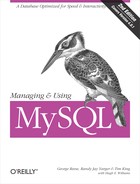Handling Results
The
second
MySQL
library function called in showgifts( ) returns
the number of rows that have been output by the query:
// Did we get back any rows?
if (@ mysql_num_rows($result) != 0)
{The function takes one parameter, the result set handle returned from
mysql_query( ).
The last MySQL function called in showgifts( )
fetches the data:
// Fetch each database table row of the results
while($row = @ mysql_fetch_array($result))
{This function retrieves row data, taking only the result set handle
returned from mysql_query( ) as a parameter. Each
call to mysql_fetch_array(
)
fetches the next row of results and
returns an array. In this example, the attributes are stored in the
array $row. The function returns
false when there are no more rows to fetch.
The attribute data stored
in the array $row can be accessed
associatively, that is, the attribute
name can be used as a key to retrieve its value. For example, the
following code prints the values of each presents
table attribute as an HTML table row:
// Display the gift data as a table row
echo "
<tr>" .
"
<td>{$row["quantity"]}</td>" .
"
<td>{$row["present"]}</td>" .
"
<td>{$row["colour"]}</td>" .
"
<td>{$row["shop"]}</td>" .
"
<td>{$row["price"]}</td>";The name of the attribute from the presents
table—for example, quantity—is used as
an index in the statement {$row["quantity"]}. The
braces are a new feature in PHP that allow all variables to be
included directly into strings that are delimited by double quotation
marks; if a variable can be unambiguously parsed from within a
double-quoted string, the braces can be omitted.
Here’s an example of the output of the above code fragment:
<tr> <td>1</td> <td>Baileys Comet 6 Ladder</td> <td>Silver</td> <td>Bunnings</td> <td>97.50</td>
The code in showgifts( ) also uses associative
array access to produce embedded links for each gift, such as:
<td><a href="action.php?action=insert&present_id=10">Add to Shopping List</a>
In this example, when the user clicks the link, the script
action.php is requested, and two parameters are
passed: action=insert and
present_id=10. In response to these parameters,
the script action.php inserts the gift with the
present_id of 10 into the shopping list of the
guest who’s logged in. The script is discussed later
in Section 11.6.
There are three tricks to accessing data returned from
mysql_fetch_array(
)
:
When both a table and attribute name are used in a
SELECTstatement, only the attribute name is used to access the data associatively. For example, after executing the statement:SELECT presents.quantity FROM presents
the data is accessed associatively as
$row["quantity"]. If two attributes have the same name, you must use aliases so that both can be accessed in the associative array. For example, the attributes in the following query:SELECT cust.name AS cname, stock.name AS sname FROM cust, stock
can be accessed in an array as
$row["cname"]and$row["sname"].Aggregate functions such as
SELECTcount(*)FROMpresentsare associatively accessed as$row["count(*)"].Prior to PHP 4.0.5,
NULLvalues were not returned into the array. This doesn’t affect associative access but causes renumbering for numeric access. If a present has acolorattribute that isNULL, the array that is returned has six elements instead of seven. The missing element can still be referenced as$row["color"]since referencing a nonexistent element returnsNULL. However, if you want to avoid arrays of different lengths being returned, ensure that all attributes have a value or upgrade to a new release of PHP.
Other MySQL library functions can be used to process result sets differently. These are discussed in Chapter 18. However, all of the basic techniques needed to develop a simple application are shown by the functions in this chapter.
